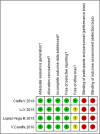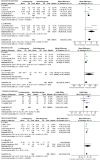Distal locked versus unlocked intramedullary nailing for stable intertrochanteric fractures, a systematic review and meta-analysis
- PMID: 32660560
- PMCID: PMC7359611
- DOI: 10.1186/s12891-020-03444-6
Distal locked versus unlocked intramedullary nailing for stable intertrochanteric fractures, a systematic review and meta-analysis
Abstract
Background: Intramedullary nails have become the main treatment for intertrochanteric fractures. However, a distal locking procedure during nailing gradually raised controversy. In this study, a systematic review and meta-analysis of clinical trials was performed to summarize existing evidence, aiming to determine the safety and efficacy of distal locking or unlocking in the nailing of stable intertrochanteric fractures.
Methods: Appropriate articles were identified using the most common public databases, such as PubMed, Embase, the Cochrane Library, and Google Scholar from the inception of each database to April 2019, without restriction of language, publication date, and considering ongoing trials. Eligible studies were represented by randomized controlled trials or retrospective cohort studies, comparing distal locking and unlocking for the treatment of acute stable intertrochanteric fractures in adult patients. Information regarding methodological quality, patient demographics, and clinical outcomes were extracted independently by two reviewers. Subsequently, patients were divided into a locking and unlocking group.
Results: This study included 9 articles, comprising a total of 1978 patients with a similar baseline. The results showed that the unlocking group had a shorter operation time, less intraoperative bleeding, lower transfusion rate, and less thigh pain after the treatment of femoral intertrochanteric fracture when compared with the distal locking group. No significant differences were observed in safety-related outcomes, including mortality, infection rate, cutting out, loss of reduction, backing out of lag screws, cephalic screw breakage, nail breakage, and peri-implant fractures between the two groups. In addition, efficacy-related outcomes including nonunion, delayed healing rates, and the Harris functional score were not significantly different between the two groups.
Conclusions: Our pooled analysis demonstrated that distal unlocking of stable intertrochanteric fractures can shorten the operation time, reduce intraoperative bleeding, and reduce the blood transfusion rate. The use of locked or unlocked intramedullary nailing does not affect long-term outcomes regarding complications and function.
Keywords: Intertrochanteric fracture; Intramedullary nails; Locked intramedullary nailing; Meta-analysis; Outcomes; Unlocked intramedullary nailing.
Conflict of interest statement
The authors declare that they have no competing interests.
Figures





References
-
- Parker MJ, Handoll HH. Gamma and other cephalocondylic intramedullary nails versus extramedullary implants for extracapsular hip fractures in adults. Cochrane Database Syst Rev. 2010;5(9):CD000093. - PubMed
Publication types
MeSH terms
Grants and funding
LinkOut - more resources
Full Text Sources
Other Literature Sources
Medical
Miscellaneous

